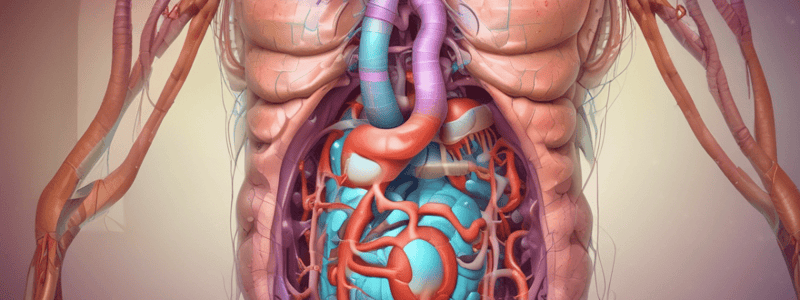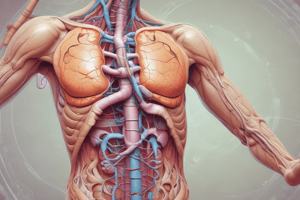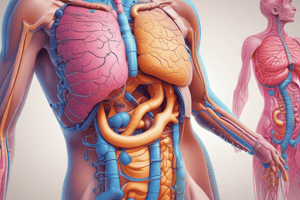Podcast
Questions and Answers
Which of the following is NOT a learning objective of L2: Digestion and absorption of nutrients?
Which of the following is NOT a learning objective of L2: Digestion and absorption of nutrients?
- Describe the digestion of protein, carbohydrates and fat from mouth to colon
- Describe the clinical consequences associated with malabsorption of nutrients
- Describe mechanisms involved in intestinal absorption of carbohydrates, proteins, fats
- Explain the anatomy of the brain in relation to digestion (correct)
What is the role of the pancreas in the digestion of fat?
What is the role of the pancreas in the digestion of fat?
- Regulates the pH of the small intestine
- Produces lipase to break down fats (correct)
- Produces bile salts to emulsify fats
- Produces enzymes to break down carbohydrates
What is the primary function of intestinal villi?
What is the primary function of intestinal villi?
- To increase the surface area for absorption of nutrients (correct)
- To regulate the blood flow to the intestines
- To move food through the intestines
- To produce hormones that regulate digestion
What is the primary site of protein digestion?
What is the primary site of protein digestion?
What is the mechanism of intestinal absorption of carbohydrates?
What is the mechanism of intestinal absorption of carbohydrates?
What is the fate of di- and tri-peptides in the small intestine?
What is the fate of di- and tri-peptides in the small intestine?
What is the clinical consequence of malabsorption of fat?
What is the clinical consequence of malabsorption of fat?
What is the primary function of the liver in the digestion of fat?
What is the primary function of the liver in the digestion of fat?
Study Notes
Overview of the Digestive System
- The digestive system consists of various organs responsible for the processing, digestion, and absorption of food.
- Key organs include the mouth, stomach, intestines, liver, and pancreas, all working together.
Digestion and Absorption of Nutrients
- Nutrients are digested from the mouth to the colon, involving a series of enzymatic reactions.
- Proteins, carbohydrates, and fats are broken down into absorbable units such as amino acids, sugars, and fatty acids.
Salivary, Gastric, and Pancreatic Secretions
- Salivary glands secrete enzymes that initiate carbohydrate digestion.
- The stomach releases gastric juices containing hydrochloric acid and pepsin, crucial for protein breakdown.
- The pancreas produces digestive enzymes (e.g., lipase, amylase, proteases) that assist in the digestion of fats, carbohydrates, and proteins.
Bile and Biliary System
- Bile is produced by the liver and is essential for the emulsification and absorption of dietary fats.
- The biliary system includes the liver, gallbladder, and bile ducts that transport bile to the small intestine.
Gut Motility
- Gut motility refers to the coordinated contractions of the gastrointestinal tract that facilitate the movement of contents.
- This process ensures proper mixing and moving of food along the digestive tract.
Intestinal Absorption Mechanisms
- Absorption occurs primarily in the small intestine, where nutrients enter the bloodstream through intestinal villi.
- Carbohydrates are absorbed as monosaccharides, proteins as amino acids or small peptides, and fats as fatty acids and monoglycerides.
Role of the Pancreas and Liver
- The pancreas provides key digestive enzymes and bicarbonate to neutralize stomach acid in the small intestine.
- The liver processes nutrients and produces bile, supporting fat digestion and absorption.
Clinical Consequences of Malabsorption
- Malabsorption can lead to deficiencies in vitamins and minerals, affecting overall health.
- Conditions such as celiac disease or pancreatic insufficiency impair nutrient absorption leading to various symptoms.
Histological Organization of Intestinal Structures
- The intestinal wall consists of layers including mucosa, submucosa, muscularis, and serosa.
- Villi and crypts are critical for increasing surface area and enabling nutrient absorption.
Absorption of Peptides and Amino Acids
- Peptides and amino acids are actively transported across the intestinal epithelium through specific transporters.
- This process is essential for providing the body with necessary building blocks for protein synthesis.
Intestinal Absorption of Oligopeptides
- Oligopeptides are absorbed via a transport process that differs from simple amino acid uptake.
- This mechanism is vital for maintaining a positive nitrogen balance and supporting growth and maintenance of tissues.
Studying That Suits You
Use AI to generate personalized quizzes and flashcards to suit your learning preferences.
Related Documents
Description
Test your knowledge on the digestive system, including digestion, absorption, and physiology of the gut. Based on lectures L1-L5 and Physiology, 5th Edition.



